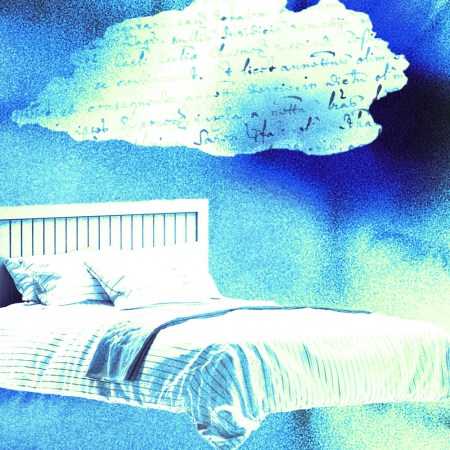There’s a key character in Big Mouth, that Netflix animation about horny middle schoolers, that hits so close to home I had to take a lengthy break from the show at one point. It’s called the Anxiety Mosquito, and like the rest of the fantastical creatures in the show, functions as an all-too-real anthropomorphic metaphor for an adolescent emotion.
But while I ride with the hilarious Hormone Monsters, and can even appreciate the poignant machinations of the Shame Wizard, I find the Anxiety Mosquito’s incessant buzzing an impossible watch. The insect flits around the noggins of embattled characters whenever they’re hoping to accomplish something — sleep, homework, asking out a crush — and reminds them of all the ways in which they’re inadequate and underserving. Its pitchy, unremitting cadence would be enough on its own to jumpstart my anxiety; the self-loathsome content makes it all the worse.
I was reminded of the Anxiety Mosquito recently, when trying to explain to a friend what listening to “brown noise” feels like. By my estimation, the sonic hue is a spiritual antonym to that dumbass fly, and in the real, three-dimensional world, a logistical antidote to racing thoughts — those of the coming-of-age variety or otherwise.
Despite the fact that brown noise was discovered nearly 200 years ago (by a Scottish botanist named Robert Brown, believe it or not…its name refers to him, not the color), it’s remained woefully under-researched ever since. And most of us have little concept of “noise colors” beyond white noise, which we associate with sleep machines and apply broadly to idling electronics.
But brown noise doesn’t sound like your boilerplate white noise. Short snippets of the sound on TikTok — often posted by accounts devoted to diagnosing and advising on adult ADHD — have racked up millions of likes. Looped or 12-hour “videos” of the sound have proliferated on YouTube. And on Twitter, users of various stripes to share the new sound they can’t stop listening to with anyone who will listen. People have called brown noise “audible adderall,” “the elite noise,” “a deep focus hack” and “clit throbbing,” which, in this case, appears to be a very good thing.
What does brown noise sound like to me? Like I’m getting hugged by the Millennium Falcon. It’s a broadband sound that sources a wide variety of frequencies, but specifically prioritizes lower frequencies. White noise, meanwhile, disseminates familiar, higher-pitched, manmade tones (close your eyes and listen to your heating/cooling unit hissing in the other room), as pink noise — which is also a thing — falls somewhere between brown and white noise.
Sound’s positive impact as a distractive element is well-documented by now; we can thank Dr. Göran Söderlund, the world’s premier authority on “auditory masking” for spending so many years investigating the relationship between ADHD, dopamine and white noise. His studies suggest that an influx of the right noise at the right time can function as a sort of blanket for the brain, allowing it to simulate dopamine release and quell intrusive or unhelpful thoughts, which can in turn improve performance (whatever “performance” may refer to in a given situation).
At the moment (despite 86 million brown noise-related views on social media) there isn’t much research yet on the particular type of noise, or much proof of the benefits it may or may not convey. Perhaps it can have a positive impact for children or adults suffering from ADHD? But what of anxiety? Or insomnia? Or tinnitus? Or a bad workday? Could brown noise possibly be a life hack for any or all of those pesky, everyday plagues?
Until the science catches up, that sort of depends on your willingness to experiment with the sound — which, fortunately, will not yield any negative side effects. (If you don’t like it, turn it off. And if you’re prompted to pay for it, either via a subscription to an ad-supported auditory stimulation steam, or a “brown noise machine” on Amazon, which don’t really exist yet, please don’t waste your money.) I’ve been listening to brown noise the entire time I’ve been writing this article. It’s thoroughly free.
The strange and unexpected solace I’ve found in brown noise appears to have something to do with its robust “rounded” sound. Brown noise brings me back to the observation dock at Niagara Falls. Others have compared it to a powerful storm a few miles away from shore. It’s rhythmic and deafening, in a way that I find both disarming and comforting. I’ve used it while writing, while reading, while sleeping. In every situation, it’s managed an abrupt dismissal of whatever nonsense was banging about my brain mere seconds before.
Sometimes the thoughts it vanquishes are the sort of things I’m used to hearing from my own Anxiety Mosquito. I have my daily demons, like anyone else. Sometimes it helps me tap into “deep work,” or the peak-work flow state in which many believe we’re at our most productive and creative. And sometimes brown drowns out annoying noises outside of my brain, like my roommate taking a Zoom call, or whatever drivel is going on downstairs. (They ripped up our street last July — I really wish I’d been aware of brown noise at the time.)
For those unable to take the plunge into the wide, confusing world meditation apps and adaptogenic capsules, consider this a clutch middle road. You don’t have to spend money or put random crap into your body, but you also might want to upgrade from counting sheep when you can’t sleep, or shooting espresso when you can’t focus. Try brown noise, at a reasonable volume, in your headphones or on a stereo. And don’t be surprised if you wake up at the other end of a night’s sleep…or at the very last line of an article.
This article was featured in the InsideHook newsletter. Sign up now.

















